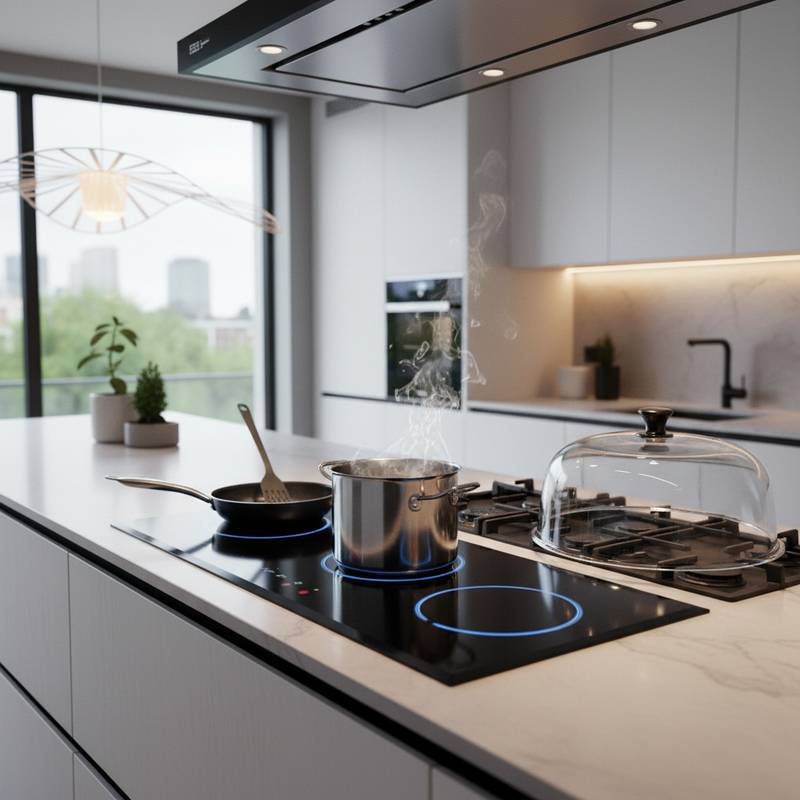Why Induction Cooktops Outperform Gas Stoves in 2025 Kitchens
Homeowners often pause in their kitchens, contemplating whether to replace a reliable gas stove. Sleek induction cooktops appear in showrooms, promising quicker boiling and simpler cleanup. The transition from gas, a longstanding favorite, requires careful consideration.
Recent advancements in induction technology, escalating energy expenses, and heightened awareness of safety and health issues with gas appliances prompt many to reassess their options. Induction cooktops emerge as more than a fad; they represent a reliable solution for enhanced performance, energy conservation, and enduring financial benefits.
This guide details the reasons induction surpasses gas in contemporary kitchens, examines authentic costs and advantages, and offers strategies to determine suitability for individual cooking preferences and financial plans.
Reasons Homeowners Reassess Gas Stoves
Gas stoves long symbolized professional-level cooking with their visible blue flames and immediate responsiveness. Emerging data on indoor air quality, coupled with rising energy tariffs and regulatory changes, alters this perspective.
Indoor Air Quality and Health Implications
Gas stoves release nitrogen dioxide, carbon monoxide, and fine particulate matter, which impact respiratory function, particularly in compact or inadequately ventilated spaces. Research associates these pollutants with elevated indoor contamination levels. Effective range hoods mitigate risks, yet numerous households lack adequate systems or fail to activate them regularly.
Induction cooktops avoid combustion processes completely. They produce no open flames, emit no gases, and pose no threat of leaks. Families with young children, older adults, or individuals managing asthma find this elimination compelling enough to warrant the investment.
To evaluate your setup, inspect ventilation during cooking sessions. If odors linger or windows require opening frequently, induction offers a proactive improvement for healthier air.
Energy Efficiency and Cost Savings
Induction technology achieves remarkable efficiency, directing 85 to 90 percent of energy straight to the cookware. Gas stoves utilize only 35 to 40 percent of their energy for actual heating, with the remainder dissipating as waste heat.
Frequent cooks observe tangible reductions in monthly utility statements, particularly where electricity pricing competes favorably with gas rates. Although initial purchases of induction units carry a premium, operational efficiencies recoup these investments within several years.
Calculate potential savings by reviewing past energy bills and estimating daily cooking duration. Tools from utility providers often simulate long-term comparisons to inform decisions.
Evolving Regulatory Landscape
Various municipalities and areas impose bans on new natural gas installations in homes under construction. These policies encourage developers and renovators to adopt all-electric kitchen configurations.
Current gas stove owners generally retain their systems, but market directions favor electric and induction alternatives as emerging norms. Forward-thinking kitchen designs incorporating induction enhance resale appeal, aligning with buyer expectations for sustainable features.
Research local ordinances through municipal websites or consult real estate professionals to anticipate impacts on property value.
Understanding Costs and Installation Essentials
Transitioning to induction extends beyond selecting a cooktop; it encompasses electrical enhancements, utensil compatibility, and surface adaptations.
Pricing and Setup Expenses
- Basic models: Range from $800 to $1,200, suitable for standard household needs.
- Intermediate options: Span $1,200 to $2,000, including features like touch controls and multiple zones.
- High-end units: Exceed $3,000, with integrated ventilation or smart connectivity.
Setup fees depend on existing wiring. Induction requires a 240-volt dedicated circuit. Homes with prior electric range infrastructure face costs of $150 to $300. New circuit installations or panel expansions elevate expenses to $500 to $1,000.
Gas stove replacements incur lower immediate fees, but ongoing servicing and exhaust system upkeep may equalize long-term outlays. Compare total ownership costs using online calculators from appliance retailers.
Selecting Compatible Cookware
Induction functions exclusively with ferromagnetic materials. Verify existing items by attaching a magnet to their bases; strong adhesion confirms usability. Cast iron, enameled cast iron, and select stainless steel varieties perform well.
Non-magnetic options like aluminum, glass, or pure copper necessitate magnetic inserts or full replacement unless already adapted. Budget $100 to $300 for essential induction-compatible sets, prioritizing multi-use pieces such as Dutch ovens and skillets.
Assess your collection systematically: Sort pots by material and identify gaps for everyday tasks like simmering sauces or searing meats.
Modifying Kitchen Surfaces
Induction cooktops align with typical cutouts for gas and electric counterparts. Measure precisely prior to purchase to avoid surprises. Larger or specialized models might demand minor edging or reinforcement adjustments.
For granite or laminate counters, professional templating ensures seamless fits. These preparations prevent cracks and maintain aesthetic integrity during the upgrade process.
Scenarios Requiring Expert Assistance
Experienced individuals handle basic electric range installations, but induction conversions frequently demand certified electricians. Consider professional involvement in these cases:
- Expanding the electrical panel to accommodate increased load demands.
- Installing fresh wiring for isolated circuits.
- Verifying adherence to regional codes and securing necessary approvals.
- Altering durable countertops like quartz or granite.
Professionals guarantee secure operations, regulatory conformity, and preservation of manufacturer warranties. Obtain multiple estimates to balance quality and affordability.
Addressing Prevalent Myths About Induction
Concerns about noise, durability, and versatility persist. Clarify these points to build confidence:
- Sound Levels: Certain cookware generates subtle hums or clicks at peak settings. These effects remain benign and diminish with use.
- Surface Durability: Glass-ceramic tops withstand regular demands, though impacts from heavy items risk minor fractures. Protective pads and mindful placement safeguard longevity.
- Utensil Restrictions: Abundant induction-specific options eliminate scarcity issues, with retailers stocking diverse, affordable lines.
Dispelling these notions reveals induction as an accessible enhancement rather than a complex shift.
Steps to Implement Your Induction Upgrade
Begin the shift from gas to induction by auditing electrical infrastructure and testing cookware adhesion. Solicit estimates from qualified electricians, examine models at local stores, and weigh energy reductions alongside wellness gains.
Inquire about incentives from power companies or authorities, which often subsidize electric conversions. These programs lower barriers, accelerating the path to a more efficient, secure kitchen environment.









